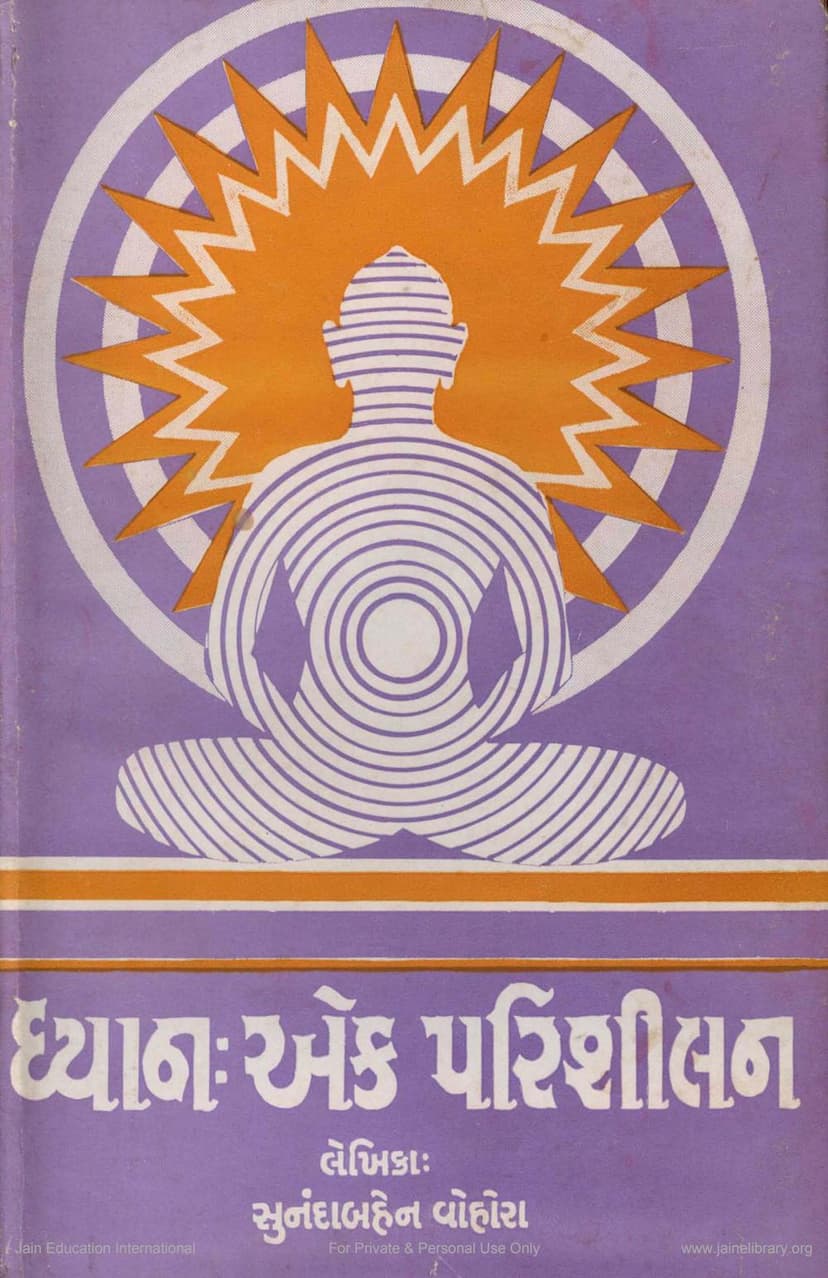Dhyana Ek Parishilan
Added to library: September 1, 2025

Summary
Certainly, here's a comprehensive summary of the Jain text "Dhyana Ek Parishilan" by Sunandaben Vohra, based on the provided pages:
Book Title: Dhyana Ek Parishilan (Meditation: A Study) Author: Sunandaben Vohra Publisher: Anandsumangal Parivar
This book is a profound exploration of meditation from a Jain philosophical perspective. It aims to guide sincere seekers (mumukshu) toward understanding and practicing meditation for spiritual well-being and liberation. The author emphasizes that meditation is not a mere ritual but an inner journey essential for attaining eternal, self-reliant bliss.
Core Themes and Structure:
The book is structured into nine "Swadhyayas" (chapters or studies), each delving into a different facet of meditation, supported by ancient Jain scriptures and the author's personal experiences. The text also includes appendices that further enrich the understanding of meditation and related spiritual practices.
Key Concepts and Content:
-
The Essence and Importance of Meditation: The book begins by establishing meditation as the highest human endeavor and the supreme spiritual practice. It highlights meditation's role in alleviating suffering and leading one towards self-realization, moving beyond transient worldly pleasures.
-
Understanding Meditation: A significant portion of the book addresses the common misconceptions and lack of clear knowledge surrounding meditation, even among practitioners. The author stresses the need for accurate understanding, distinguishing true meditation from mere physical postures, imagination, or the pursuit of supernatural powers.
-
Meditation in Jain Philosophy: The text emphasizes the depth and subtlety of meditation within Jainism, noting the consistency of principles across various Jain traditions. It explains how meditation is integrated into the Jain path, particularly through Dharma Dhyana (virtuous meditation) and Shukla Dhyana (pure meditation), which are the highest forms, accessible mainly to ascetics. The book also clarifies the importance of Samyak Darshan (right faith) as a prerequisite for true Dharma Dhyana.
-
The Path to Meditation: The book details the foundational elements required for effective meditation:
- Mind Purification (Manah Shuddhi): This is presented as the bedrock of meditation. It involves practicing virtues like truthfulness, integrity, generosity, love, and detachment.
- Self-Observation (Swa-Nirikshan): This involves honest introspection to identify and overcome one's faults and enhance virtues, moving from a self-centered perspective to a more neutral observation.
- Mind Stillness (Chitta Sthirta): The text explains how mental stillness is achieved through various practices like controlled breathing, concentration exercises, and mindful observation. This stillness is crucial for progressing in meditation.
- Yoga Practices: While acknowledging various forms of yoga, the book positions them as preparatory or supportive practices for the deeper spiritual journey within Jainism, emphasizing that the ultimate goal is self-realization, not mere physical or Siddhi attainment. The appendices reference texts like the Yoga Sutras of Patanjali and Yoga Drishti Samuchchaya.
-
The Role of Right Faith, Knowledge, and Conduct: The book elaborates on the Jain concept of Ratnatraya (the three jewels: Right Faith, Right Knowledge, and Right Conduct) as the essence of the path to liberation and the foundation of true meditation.
-
Practical Guidance: The book offers practical advice for daily meditation, including:
- Ideal Times: Suggesting early morning (Brahma Muhurta) and evening.
- Environment: Recommending quiet, pure, and secluded places.
- Posture: Emphasizing comfortable and stable seating.
- Techniques: Discussing breath awareness (shvasa-anupreksha), mantra chanting, contemplation of divine forms, and introspection.
- Stages of Practice: Outlining different levels of practice for beginners, intermediate, and advanced practitioners.
-
Addressing Challenges and Misconceptions: The author tackles common challenges faced by meditators, such as mind wandering, the allure of psychic powers, the importance of discipline, and the difference between mere ritual and true spiritual practice. She cautions against misleading teachings and emphasizes the necessity of guidance from an experienced guru.
-
The Ultimate Goal: The book consistently points towards self-realization and liberation (Moksha) as the ultimate aim of meditation, not worldly gains or supernatural abilities. It highlights that true happiness and peace are found within the self.
-
Appendices: The appendices provide deeper insights into various meditative practices, quoting from revered Jain Acharyas like Shri Yashovijayji Upadhyaya, Shrimad Rajchandra, and Shri Kesarsuriji, as well as referencing broader yogic traditions.
Overall Message:
"Dhyana Ek Parishilan" is a comprehensive guide that demystifies meditation, presenting it as an accessible yet profound spiritual discipline. It advocates for a balanced approach, integrating ethical living, self-discipline, and intellectual understanding with heartfelt devotion and consistent practice. The book serves as a valuable resource for anyone seeking to deepen their spiritual journey through the practice of meditation, grounded in the timeless wisdom of Jainism.